Kuala Lumpur probably lands in the top five easiest places to travel to for Juans. With the city gaining popularity and with the increasing number of daily flights, more Juans are looking at KL as an ideal and good value-for-money travel destination.
If you are planning to visit KL, it's best to know a few of the basics. So here's our guide for first time travelers to Malaysia's world city.
The City
The name Kuala Lumpur literally means "muddy confluence". This is because it was founded where the rivers Klang and Gombak merge. It started as a small mining town and has grown to be Malaysia's most important urban center.
Today, KL is one of the world's leading cities for tourism and shopping. In 2017 alone, it welcomed more than 12 million international visitors. It boasts of its impressive skyscrapers, huge malls, and extensive public transport network.
Travel Requirements
There are around 160 countries in the world that are granted free-visa entry to Malaysia with varying length of stays. Filipinos and citizens of other ASEAN countries can stay in the country without the need for tourist visa for stays no longer than 30 days. Passports also need to be valid for at least six months at the time of entry.
For more details, visit the website of the Immigration Department of Malaysia here.
Time Zone
Malaysia Standard Time is eight hours ahead of Greenwich Mean Time (GMT +8). This means that the Philippines and Malaysia are in the same time zone. But since Malaysia is to the west of the Philippines, they experience later sunrise and sunsets there.
Malaysia Electricity
In Malaysia the power sockets are type G. Make sure to bring a three-pinned rectangular adapter so you can charge your devices.
The standard voltage is 240V and the standard frequency is 50Hz. Many of today's devices such as mobile phone chargers will automatically switch to the network voltage and will work fine. However, always check your device's voltage before traveling as connecting it to the wrong voltage might damage your device.
Currency
The currency in Kuala Lumpur is the Malaysia Ringgit (MYR). The bills come in denominations of 1, 5, 10, 20, 50, and 100. The bills come in different colors and sizes for easier identification. The Ringgit is further divided into coins called sen with 100 sen to MYR1. The coins come in denominations of 5, 10, 20, and 50.
So where to exchange Peso to the Ringgit? Based on experience, we enjoyed better exchange rates in downtown KL. However, upon arrival at the airport, you'll need some local cash for transportation from the airport, for food or for some extras. If you have to exchange money at the airport, exchange the smallest possible amount as airports have the worst exchange rates. We just exchanged PHP1,000 at the Maybank Counter for a rate of PHP1.00=MYR0.070, enough for our bus service going to the city. We later changed the rest of our money at Plaza Sungei Wang in Bukit Bintang at a rate of PHP1.00=MYR0.074. This was the best rate compared to the ones we checked within the bigger malls of KL and even in Manila prior to our trip.
Additional Tip: MYR don't have 500 and 1,000 bills as these have been demonetized before the year 2000. There's also no need to exchange your Peso to Dollar and then to Ringgit as you will lose money in the process.
How to Get There
Downtown KL is approximately 45 kilometers from Kuala Lumpur International Airport. It is accessible by direct flights from many Asian cities. From Manila, there are eight daily flights to Kuala Lumpur. These flights are operated by Air Asia, Cebu Pacific, Philippine Airlines, and Malaysia Airlines. Flight time takes about 3 hours and 45 minutes.
Aside from checking directly with the airlines, we also use the app Traveloka as a go-to site for flight deals. The site is helpful when you want to search, compare, and book flights and hotels that fit your budget and schedule. Check it out by visiting its website or downloading the app in your smart phone.
When to Visit
Kuala Lumpur features a tropical rainforest climate which is warm, sunny, and with abundant rainfall. The drier months run from December to February and May to August. These months also fall within the peak season so expect the rush of tourists and more expensive accommodation. The wetter months run from March to April and September to November. When we visited last March, we experienced rain for most of the time we spent exploring the city.
Tip: Wear light clothing to stay cool as it tends to get really humid in KL. It's also a good idea to bring along an umbrella just in case it rains.
Where to Stay
With more than 60,000 hotel rooms in the city, visitors to KL will have a wide range of accommodation options from no-frills backpacker inns to luxurious five-star hotels.
We stayed at the inspiring The Hulo Hotel + Gallery. The hotel is Malaysia's first boutique hotel that features the works of the country's foremost creative talents - from custom toys, sculptures, and paintings to furniture. Each of the hotel's 63 rooms showcases the works of one creative personality. Each designed and decorated according to the vision of that artist.
The hotel also boasts its strategic location. It is within walking distance to KL's shopping and entertainment district, Bukit Bintang. It is approximately 450 meters to Berjaya Times Square or Imbi Station and 630 meters to Sung Wei Plaza.
When booking, we always compare rates from the hotel websites to booking sites like Agoda or Hotels.com. This way we are able check for the best deals. We booked a Standard Room for only PHP646.30 per night via Agoda as it offered the lowest price with additional discounts through BPI credit cards.
Read our review of the hotel: Hulo Hotel + Gallery: Waking Up Next to World-Class Art
Getting Around
Getting around Kuala Lumpur is easy with several transportation options available. The options include traveling by bus, train, taxi, or ride-hailing platform.
Taking the bus is cheap but can be inefficient during traffic gridlocks. Main operators are Metrobus, RapidKL, and City Liner. There is also the government sponsored GoKL City Buses that provide free bus service along the city's major tourist spots including Bukit Bintang, Chinatown, and KLCC.
The train is the most widely used public transportation option in KL. It is a reliable way to get around as many of its stations are located in popular areas of the city. However, it often does not provide direct access and will require pairing with walking or taking a taxi/Grab to the destination. It can also get really crowded during rush hours. The train system of KL includes two light rail transit lines, a monorail line, two commuter rail lines, and an airport rail link.
Taxis are available 24 hours and can be hailed throughout the city. But similar to other major cities in Southeast Asia, taxis in KL are known for not using the meter and for charging exorbitant fares from tourists. Be cautious and ask to turn on the meter. Also, taking the taxi after midnight will cost night surcharges.
The ride hailing platform Grab is also available in KL. This is an option for a convenient, safe, and reliable door-to-door transportation. Taking GrabCar or GrabShare guarantee upfront fixed fares so they make good alternatives to taking taxis.
For our tour in the city, we booked the KL Hop-On Hop-Off City Tour. This is a free and easy tour bus service that has 23 stops covering more than 70 of the city's attractions. This is definitely the easiest way for first timers, who usually don't know where to start, to visit the highlights of KL using a single mode of transportation. For more information, check out the website here.
Tip: The tickets for the tour can be purchased in the bus, authorized agents/hotels, KL Hop-On Hop-Off Counters or the website. Buy through the website to enjoy MYR5 discount per person.
Read about our experience: City Sightseeing Onboard the KL Hop On Hop Off Bus
Places to Visit
1. Petronas Towers
Soaring to a height of 451.9 meters, the Petronas Twin Towers is Kuala Lumpur's crown jewel and its most iconic landmark. It held the title of the world's tallest building from 1998 to 2004. The design of the building is said to be based on Islamic geometric forms of eight-pointed stars.
You can enjoy views of the towers from the KLCC Park for free at any time of the day. You can also get inside the building and enjoy views from the Skybridge and Observation Deck at a cost. Visits are available from Tuesdays to Sundays from 9:00AM to 9:00PM. Tickets are priced at MYR85 per person, however, these are limited and issued on a first come first served basis. To do an advance purchase, please visit the site here.
2. Muzium Negara
Located in the heart of KL, Muzium Negara or the National Museum provides a good introduction to Malaysia's cultural and historical heritage. The museum is built in the style of Rumah Gadang or traditional homes of the Minangkabau. It features four galleries - the Prehistory Gallery, the Malay Kingdoms Gallery, the Colonial Era Gallery, and the Malaysia Today Gallery.
The museum is open daily from 9:00AM to 6:00PM. Tickets are priced at MYR5 for adults 13 years and above and MYR2 for children 6-12 years old.
Also read:
In Photos: Muzium Negara's Prehistory and the Malay Kingdoms Galleries (Part I)
In Photos: Muzium Negara's Colonial Era and Malaysia Today Galleries (Part II)
3. Merdeka Square and Sultan Abdul Samad Building
Literally means Independence Square, the Dataran Merdeka is the place where the British flag was lowered and the Malaysian flag was raised for the very first time on August 31, 1957. From then on, the square has been the venue of the annual National Day Parade as well as political rallies and events.
Surrounding the square are many buildings of interest including the Sultan Abdul Samad Building. The building named after Sultan Abdul Samad of Selangor was completed in 1897. The building is constructed entirely of brick with strong gothic, western, and Moorish-style influences. It once housed the British colonial offices and is now occupied by the Ministry of Information, Communications and Culture of Malaysia.
Both the Merdeka Square and Sultan Abdul Samad Building can be visited and enjoyed any time of the day for free.
4. Perdana Botanical Garden
Also known as the Lake Gardens, Perdana Botanical Garden is KL's green lung. It is a 91.6-hectare recreational park that is comprised of well-manicured gardens, landscaped hills, and man-made lakes.
Among the popular tourist attractions located in the Lake Gardens are the National Monument, Deer Park, Hibiscus Garden, Orchid Garden, KL Bird Park and KL Butterfly Park.
The garden is open daily from 9:00AM to 6:00PM. Entrance is free all year long although visiting the Orchid Garden and Hibiscus Garden costs MYR1 during weekends. The bird park and butterfly park are also ticketed attractions within the garden.
5. Planetarium Negara
Planetarium Negara is the national planetarium of Malaysia. It is a blue-domed structure, designed to resemble a mosque, that sits on a hill east of the Lake Gardens. The planetarium features a series of halls containing exhibits such as the interactive mock up interior of the International Space Station and the Arianne IV space engine, used to launch Malaysia's first satellite into space. There is also the Observatory Park where replicas of ancient observatories like the Jai Singh and Stonehenge are sited. The highlight of the planetarium, however, is the Space Theater. This is a theater that shows short, wide screen films and documentaries projected on the ceiling of the dome. Viewers get to watch the short films on reclined seats giving a panoramic viewing effect.
The Planetarium Negara is open on Tuesdays to Sundays from 9:00AM to 4:30PM. Entrance to the exhibition gallery is free while the Space Theater is MYR12 for adults and MYR8 for children 2-12 years old. For more information, visit the planetarium's website here.
Also read: A Starlit Afternoon at Malaysia's Planetarium Negara
6. National Mosque
The National Mosque is an important symbol of the Islamic country of Malaysia. It can accommodate up to 15,000 people making it one of the largest mosques in Southeast Asia. Its unique modern design embodies a contemporary expression of traditional Islamic art, calligraphy and ornamentation. Its key features include a 73-meter high minaret in the shape of a folded umbrella and a 16-pointed star concrete main roof reminiscent of an open umbrella.
The mosque is open daily but with designated timings for non-Muslim visitors. It is open daily for all between 9:00AM to 12:00NN, 3:00PM to 4:00PM and 5:30PM to 6:30PM, except Fridays when it is open between 3:00PM to 4:00PM and 5:30PM to 6:30PM.
7. KL Tower
Aside from the Petronas, KL Tower is also one of the most recognizable landmarks of Kuala Lumpur. It is a communications tower with a height of 421 meters making it the 7th tallest free standing tower in the world. Its key features are the Observation Deck, Sky Deck, Sky Box, and the revolving Atmosphere 360 restaurant.
The KL Tower is open daily from 9:00AM to 10:00PM. Admission Ticket to the Observation Deck is MYR52 while the Sky Deck is MYR105. There are combo tickets and packages available here. You can also view the tower from its base or from Bukit Nanas for free.
8. Genting Highlands
If you have enough time, visit Genting Highlands, an integrated resort development comprised of hotels, shopping malls, theme parks, and casinos, perched on the peak of Mount Ulu Kali. By 2019, the resort will be home to the first 20th Century Fox World movie theme park.
Genting Highlands is located north of Kuala Lumpur and is at least 45 minutes away. It is accessible by bus from KL Sentral with buses departing on an hourly basis. One way fare is at MYR12.30 for adults and MYR11.30 for children.
Where to Eat
Drop by Jalan Alor, KL's famous night market and street food row. Here, you'll find an assortment of restaurants and stalls selling affordable food that represent Malaysia.
As KL is dotted with modern shopping malls, there are also a wide variety of restaurant options inside these malls. These restaurants serve food ranging from local flavors to international favorites.
Budget
Usual packages offered by travel agencies are priced at more than PHP12,000 with no inclusions for tours and activities. Here's our budget guide to share how we were able to travel to KL for less than PHP9,900 all in: Kuala Lumpur: A Budget Travel Guide for Juans
This guide is designed based on our experience and we hope this is of use to Juans who plan to travel for the first time to Kuala Lumpur.
Have you visited KL? If you wanna share your experiences, please leave a comment or suggestion below. If you find this useful, please share on social media. Thanks!
If you are planning to visit KL, it's best to know a few of the basics. So here's our guide for first time travelers to Malaysia's world city.
The City
The name Kuala Lumpur literally means "muddy confluence". This is because it was founded where the rivers Klang and Gombak merge. It started as a small mining town and has grown to be Malaysia's most important urban center.
Today, KL is one of the world's leading cities for tourism and shopping. In 2017 alone, it welcomed more than 12 million international visitors. It boasts of its impressive skyscrapers, huge malls, and extensive public transport network.
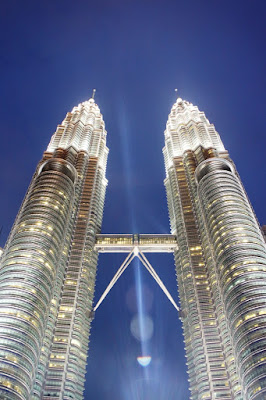 |
| The iconic Petronas Twin Towers |
There are around 160 countries in the world that are granted free-visa entry to Malaysia with varying length of stays. Filipinos and citizens of other ASEAN countries can stay in the country without the need for tourist visa for stays no longer than 30 days. Passports also need to be valid for at least six months at the time of entry.
For more details, visit the website of the Immigration Department of Malaysia here.
Time Zone
Malaysia Standard Time is eight hours ahead of Greenwich Mean Time (GMT +8). This means that the Philippines and Malaysia are in the same time zone. But since Malaysia is to the west of the Philippines, they experience later sunrise and sunsets there.
Malaysia Electricity
In Malaysia the power sockets are type G. Make sure to bring a three-pinned rectangular adapter so you can charge your devices.
 |
Currency
The currency in Kuala Lumpur is the Malaysia Ringgit (MYR). The bills come in denominations of 1, 5, 10, 20, 50, and 100. The bills come in different colors and sizes for easier identification. The Ringgit is further divided into coins called sen with 100 sen to MYR1. The coins come in denominations of 5, 10, 20, and 50.
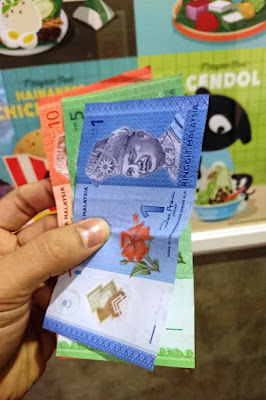 |
| The Ringgit in various sizes and colors |
Additional Tip: MYR don't have 500 and 1,000 bills as these have been demonetized before the year 2000. There's also no need to exchange your Peso to Dollar and then to Ringgit as you will lose money in the process.
How to Get There
Downtown KL is approximately 45 kilometers from Kuala Lumpur International Airport. It is accessible by direct flights from many Asian cities. From Manila, there are eight daily flights to Kuala Lumpur. These flights are operated by Air Asia, Cebu Pacific, Philippine Airlines, and Malaysia Airlines. Flight time takes about 3 hours and 45 minutes.
Aside from checking directly with the airlines, we also use the app Traveloka as a go-to site for flight deals. The site is helpful when you want to search, compare, and book flights and hotels that fit your budget and schedule. Check it out by visiting its website or downloading the app in your smart phone.
When to Visit
Kuala Lumpur features a tropical rainforest climate which is warm, sunny, and with abundant rainfall. The drier months run from December to February and May to August. These months also fall within the peak season so expect the rush of tourists and more expensive accommodation. The wetter months run from March to April and September to November. When we visited last March, we experienced rain for most of the time we spent exploring the city.
Tip: Wear light clothing to stay cool as it tends to get really humid in KL. It's also a good idea to bring along an umbrella just in case it rains.
Where to Stay
With more than 60,000 hotel rooms in the city, visitors to KL will have a wide range of accommodation options from no-frills backpacker inns to luxurious five-star hotels.
We stayed at the inspiring The Hulo Hotel + Gallery. The hotel is Malaysia's first boutique hotel that features the works of the country's foremost creative talents - from custom toys, sculptures, and paintings to furniture. Each of the hotel's 63 rooms showcases the works of one creative personality. Each designed and decorated according to the vision of that artist.
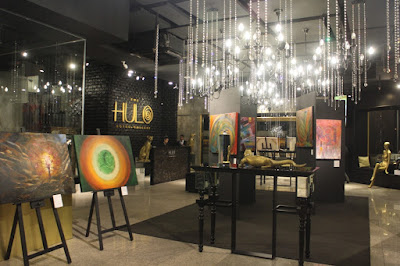 |
| The lobby turned gallery of Hulo Hotel + Gallery |
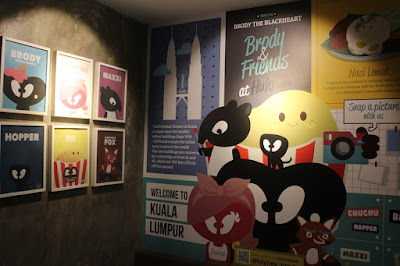 |
| Our hotel room designed by Zack Tay |
When booking, we always compare rates from the hotel websites to booking sites like Agoda or Hotels.com. This way we are able check for the best deals. We booked a Standard Room for only PHP646.30 per night via Agoda as it offered the lowest price with additional discounts through BPI credit cards.
Read our review of the hotel: Hulo Hotel + Gallery: Waking Up Next to World-Class Art
Getting Around
Getting around Kuala Lumpur is easy with several transportation options available. The options include traveling by bus, train, taxi, or ride-hailing platform.
Taking the bus is cheap but can be inefficient during traffic gridlocks. Main operators are Metrobus, RapidKL, and City Liner. There is also the government sponsored GoKL City Buses that provide free bus service along the city's major tourist spots including Bukit Bintang, Chinatown, and KLCC.
The train is the most widely used public transportation option in KL. It is a reliable way to get around as many of its stations are located in popular areas of the city. However, it often does not provide direct access and will require pairing with walking or taking a taxi/Grab to the destination. It can also get really crowded during rush hours. The train system of KL includes two light rail transit lines, a monorail line, two commuter rail lines, and an airport rail link.
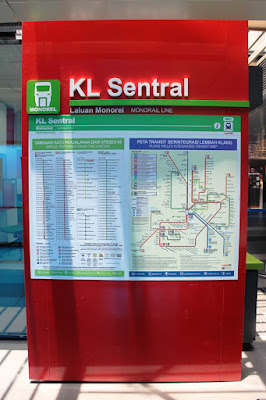 |
| The Integrated Transit Guide of Kuala Lumpur |
The ride hailing platform Grab is also available in KL. This is an option for a convenient, safe, and reliable door-to-door transportation. Taking GrabCar or GrabShare guarantee upfront fixed fares so they make good alternatives to taking taxis.
For our tour in the city, we booked the KL Hop-On Hop-Off City Tour. This is a free and easy tour bus service that has 23 stops covering more than 70 of the city's attractions. This is definitely the easiest way for first timers, who usually don't know where to start, to visit the highlights of KL using a single mode of transportation. For more information, check out the website here.
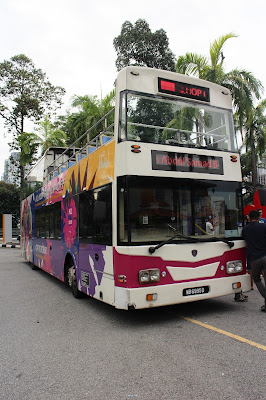 |
| KL's Hop On Hop Off Bus |
Read about our experience: City Sightseeing Onboard the KL Hop On Hop Off Bus
Places to Visit
1. Petronas Towers
Soaring to a height of 451.9 meters, the Petronas Twin Towers is Kuala Lumpur's crown jewel and its most iconic landmark. It held the title of the world's tallest building from 1998 to 2004. The design of the building is said to be based on Islamic geometric forms of eight-pointed stars.
 |
| The stunning Petronas Twin Towers |
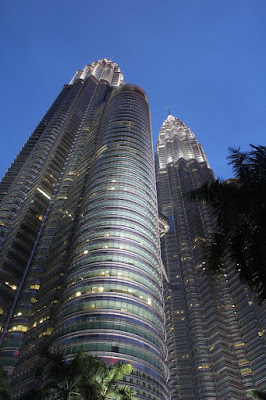 |
| Petronas as seen from another angle |
 |
| The equally impressive Public Bank Berhad across Petronas Twin Towers |
2. Muzium Negara
Located in the heart of KL, Muzium Negara or the National Museum provides a good introduction to Malaysia's cultural and historical heritage. The museum is built in the style of Rumah Gadang or traditional homes of the Minangkabau. It features four galleries - the Prehistory Gallery, the Malay Kingdoms Gallery, the Colonial Era Gallery, and the Malaysia Today Gallery.
The museum is open daily from 9:00AM to 6:00PM. Tickets are priced at MYR5 for adults 13 years and above and MYR2 for children 6-12 years old.
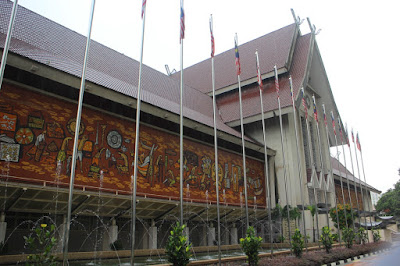 |
| Muzium Negara in traditional Minangkabau style building |
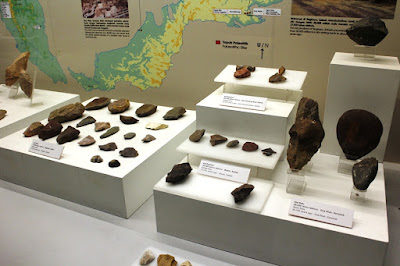 |
| The Prehistory Gallery |
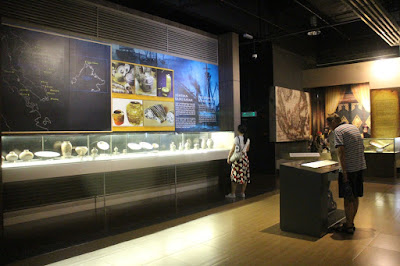 |
| The Malay Kingdoms Gallery |
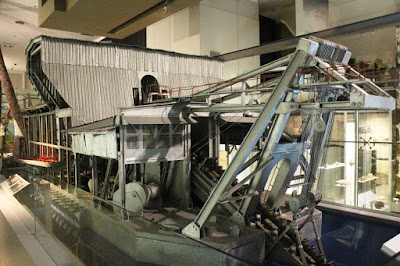 |
| The Colonial Era Gallery |
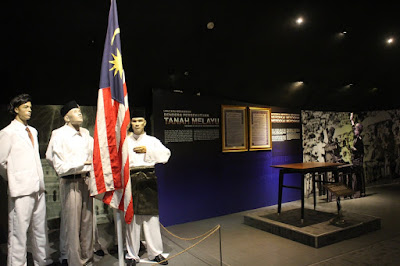 |
| The Malaysia Today Gallery |
In Photos: Muzium Negara's Prehistory and the Malay Kingdoms Galleries (Part I)
In Photos: Muzium Negara's Colonial Era and Malaysia Today Galleries (Part II)
3. Merdeka Square and Sultan Abdul Samad Building
Literally means Independence Square, the Dataran Merdeka is the place where the British flag was lowered and the Malaysian flag was raised for the very first time on August 31, 1957. From then on, the square has been the venue of the annual National Day Parade as well as political rallies and events.
Surrounding the square are many buildings of interest including the Sultan Abdul Samad Building. The building named after Sultan Abdul Samad of Selangor was completed in 1897. The building is constructed entirely of brick with strong gothic, western, and Moorish-style influences. It once housed the British colonial offices and is now occupied by the Ministry of Information, Communications and Culture of Malaysia.
Both the Merdeka Square and Sultan Abdul Samad Building can be visited and enjoyed any time of the day for free.
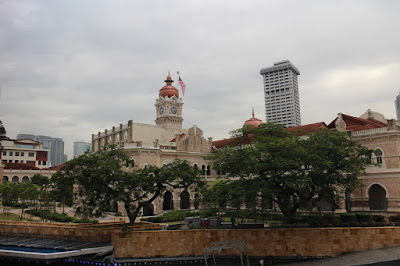 |
| Sultan Abdul Samad Building from behind |
Also known as the Lake Gardens, Perdana Botanical Garden is KL's green lung. It is a 91.6-hectare recreational park that is comprised of well-manicured gardens, landscaped hills, and man-made lakes.
Among the popular tourist attractions located in the Lake Gardens are the National Monument, Deer Park, Hibiscus Garden, Orchid Garden, KL Bird Park and KL Butterfly Park.
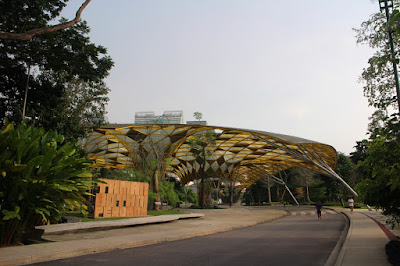 |
| Perdana Botanical Garden |
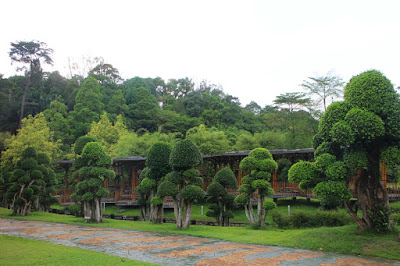 |
| The Topiary Collection of the Gardens |
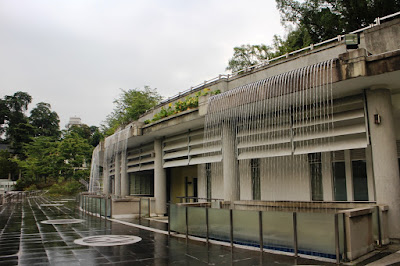 |
| Fountains near the KL Garden Ampitheater |
5. Planetarium Negara
Planetarium Negara is the national planetarium of Malaysia. It is a blue-domed structure, designed to resemble a mosque, that sits on a hill east of the Lake Gardens. The planetarium features a series of halls containing exhibits such as the interactive mock up interior of the International Space Station and the Arianne IV space engine, used to launch Malaysia's first satellite into space. There is also the Observatory Park where replicas of ancient observatories like the Jai Singh and Stonehenge are sited. The highlight of the planetarium, however, is the Space Theater. This is a theater that shows short, wide screen films and documentaries projected on the ceiling of the dome. Viewers get to watch the short films on reclined seats giving a panoramic viewing effect.
 |
| The mosque-like structure of Planetarium Negara |
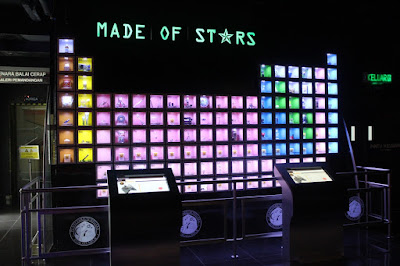 |
| Exhibition Gallery featuring the science of stars |
 |
| The Arianne IV Space Engine |
Also read: A Starlit Afternoon at Malaysia's Planetarium Negara
6. National Mosque
The National Mosque is an important symbol of the Islamic country of Malaysia. It can accommodate up to 15,000 people making it one of the largest mosques in Southeast Asia. Its unique modern design embodies a contemporary expression of traditional Islamic art, calligraphy and ornamentation. Its key features include a 73-meter high minaret in the shape of a folded umbrella and a 16-pointed star concrete main roof reminiscent of an open umbrella.
 |
| Malaysia's National Mosque |
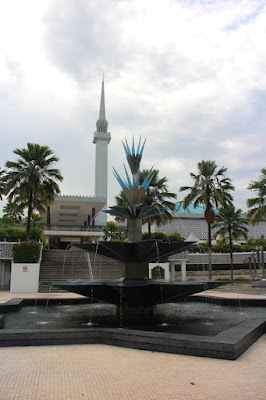 |
| A fountain complementing the mosque |
Aside from the Petronas, KL Tower is also one of the most recognizable landmarks of Kuala Lumpur. It is a communications tower with a height of 421 meters making it the 7th tallest free standing tower in the world. Its key features are the Observation Deck, Sky Deck, Sky Box, and the revolving Atmosphere 360 restaurant.
 |
| The KL Tower |
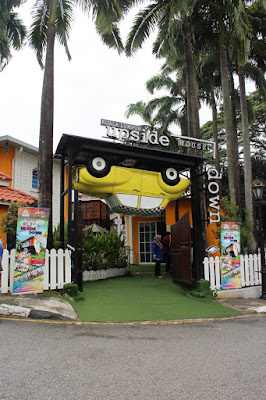 |
| KL's Upside Down House, one of the ticketed attractions in KL Tower |
8. Genting Highlands
If you have enough time, visit Genting Highlands, an integrated resort development comprised of hotels, shopping malls, theme parks, and casinos, perched on the peak of Mount Ulu Kali. By 2019, the resort will be home to the first 20th Century Fox World movie theme park.
Genting Highlands is located north of Kuala Lumpur and is at least 45 minutes away. It is accessible by bus from KL Sentral with buses departing on an hourly basis. One way fare is at MYR12.30 for adults and MYR11.30 for children.
Where to Eat
Drop by Jalan Alor, KL's famous night market and street food row. Here, you'll find an assortment of restaurants and stalls selling affordable food that represent Malaysia.
As KL is dotted with modern shopping malls, there are also a wide variety of restaurant options inside these malls. These restaurants serve food ranging from local flavors to international favorites.
Budget
Usual packages offered by travel agencies are priced at more than PHP12,000 with no inclusions for tours and activities. Here's our budget guide to share how we were able to travel to KL for less than PHP9,900 all in: Kuala Lumpur: A Budget Travel Guide for Juans
This guide is designed based on our experience and we hope this is of use to Juans who plan to travel for the first time to Kuala Lumpur.
Have you visited KL? If you wanna share your experiences, please leave a comment or suggestion below. If you find this useful, please share on social media. Thanks!

This is just the information I am finding everywhere. Thanks for your blog, I just subscribe your blog. This is a nice blog.. thetravelstreet.com
ReplyDelete